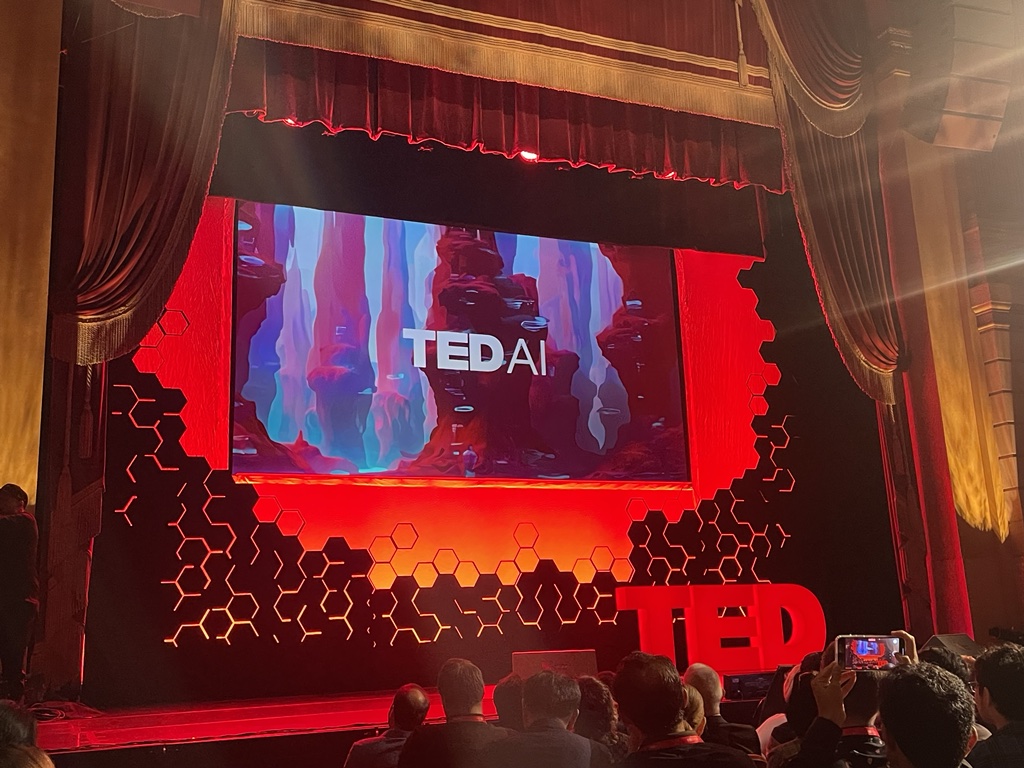
By Rafe Needleman
I looked forward to having my mind blown at TED AI Oct.17 and 18, the first TED event focused exclusively on artificial intelligence (AI). I did walk away in awe of the potentials in this new AI-powered world. But at the same time, the stories told from the stage – especially some of the early talks by marquee-level speakers – left me wanting more.
It got me thinking about the stories I heard and witnessed. As communicators, we think about not just the content, but how that content is delivered. Much of what I heard at TED AI had the beginnings of really great stories… and occasionally incredible story endings. But as AI becomes an intrinsic part of our lives, the conversations about its promise, power and potential pitfalls have to be deeper and more prescriptive. Beginnings are simply not enough anymore.
In other words, let’s not start AI stories we can’t finish. We all have both a responsibility and the ability to do better. Here are four ways to do so.
1. The human angle
AI may represent an existential threat to our humanity. Or maybe its salvation. But ultimately the best, most relatable stories have characters in them, and using the word “humanity” is oddly not all that relatable.
So, how can we give our technology story a protagonist?
At the conference, I met Abhinav Das, co-founder of the startup Orangewood Labs, which works on low-cost, AI-enhanced industrial robots. He told me his product is so cost-effective that it is competitive with low-wage workers in India, where his first customers are. So, I asked if he was concerned about the impact of this technology on jobs.
He responded with a story about a factory worker he met, whose job was to paint propane tanks – a job the robot now did. Was this a sad story of job loss, then? No, because according to the founder, the painter was overjoyed. “I don’t want to do this anymore,” he said, “and I don’t want my son to do it either.” He looks forward to an economy where he could do something else. And just like that, his story about robots transformed into a story about one man and the son he loved.
2. The practical or visual example
AI is not a theory. Everyone using ChatGPT or DALL-E can attest the technology is very real. So, when communicating about AI, you need to go beyond theory or potential to be memorable. Back up ideas with real-world examples if possible. Show your work.
Eric Topol, a physician and founder of the Scripps Research Translational Institute, gave a talk about, among other things, the power of AI to see what human doctors cannot. He illustrated his story by showing different medical scans – retina images and electrocardiograms – and pointing out how AIs have been able to diagnose conditions in these scans that were connected to different organs. For example, from retina scans, AI can diagnose Alzheimer’s and Parkinson’s before symptoms emerge, as well as kidney, liver or gall bladder disease.
Show, don’t just tell. Hype and theory aren’t enough. Impact and real-world examples are golden.
3. The pithy soundbite
When spinning a tale about AI, it’s easy to get lost in the weeds and even easier to ramble. Especially at events where panels sessions are common, speakers must work even harder to make what they say memorable. The best way to break through the wall of forgettable: the well-crafted soundbite.
Case in point… Raj Ronanki, founder of the AI-powered healthcare financial technology company Lyric [Disclosure: Lyric is an Allison client], said at the end of his talk, “The prompt is you.” It was the perfect coda to a discussion about how we should all be the “asset managers” of our own biological data – and how our data could be the “prompt” into large language models (LLMs) that would provide us with customized and cost-effective pointers to the right medical advice and the best services for us.
Elegant in its simplicity, those four resonant words clearly distilled the complex potential of AI-powered medicine and healthcare for a TED audience of varying AI knowledge and backgrounds.
4. The unique perspective and style
Do you need to say the same thing others say? More importantly, does your audience need to hear it again?
What can you say – or do – that sets you apart?
What the audience wants to hear – and what they will remember – is your unique perspective. Don’t be afraid to deliver an opinion or data point that runs perhaps a little (or a lot) outside or ahead of the mainstream conversation. That is how the global conversation moves forward. It’s how you stand out in a sea of sameness.
Rafe Needleman is Senior Vice President of Technology Editorial for Allison. He joined the firm after more than 20 years as a technology journalist, serving as editor-in-chief of publications such as Red Herring Online, Byte, Yahoo Tech, and CNET Reviews. He also worked for several years as a thought leadership content creator for a Fortune 500 enterprise technology firm.